39 Beautiful Native Hawaiian Flowers You Must See
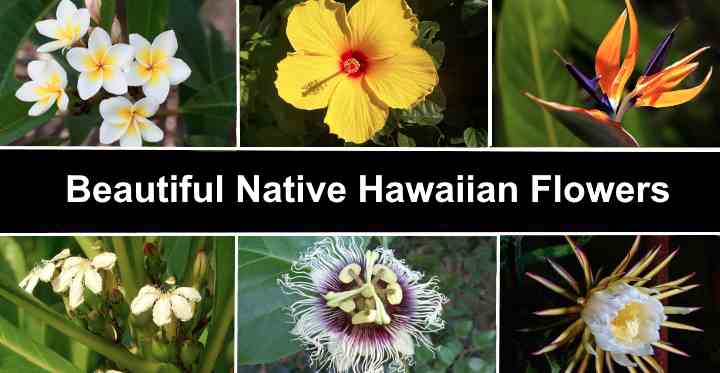
Hawaii is home to a diverse range of beautiful, colorful, exotic-looking flowers. Hawaii’s flora and fauna are unique to the island state, with many native and endemic tropical flowers only found on the archipelago. From the stunning native yellow hibiscus shrubs to exotic flowers like Hawaiian lobelioids, Nanu, kokolau, and ohia lehua, native flowers from Hawaii never fail to impress in the tropical paradise.
Native Hawaiian flowers have adapted to the archipelago’s unique climate and volcanic soil. In addition to adding vibrant colors to lush landscapes, flowers in Hawaii are important to Hawaiian culture and traditions. For example, native flowers are used to create leis—garlands used to express love and “Aloha.”
This article explores the captivating beauty of native Hawaiian flowers. Pictures and descriptions of the blossoms that make Hawaii’s flora exceptional will help you uncover the stunning world of exotic flowers.
Types of Hawaiian Flowers
Flowers in Hawaii can be categorized into four main groups—native, indigenous, endemic, and non-native. Some non-native flowers like frangipani have naturalized well and have a vital role in Hawaiian traditions and culture.
Here are short descriptions of the types of Hawaiian flowers you can discover on the islands:
Native Hawaiian flowers: These plants naturally occur on the Hawaiian islands without human intervention. These plants have adapted to the local climate, soil, and other environmental conditions, forming an integral part of the ecosystem. They play a crucial role in maintaining biodiversity and supporting wildlife.
Endemic Hawaiian flowers: These native plants are found exclusively in one or more of Hawaii’s eight major islands. Endemic plants play a crucial role in the ecological balance of the ecosystems in Hawaii.
Indigenous Hawaiian flowers: These plant species are also native to the archipelago but are also found in other geographic locations. Like native and endemic plants, they are vital for biodiversity in local ecosystems.
Non-native Hawaiian flowers: These types of plants arrived in Hawaii by humans, either intentionally or unintentionally. Non-native plants can sometimes outcompete native species, disrupting biodiversity. However, some non-native plants naturalize well and become part of the local flora and fauna.
Native Hawaiian Flowers
Let’s look at some of the stunning native plants with beautiful flowers in Hawaii. Some Hawaiian plants are non-native but have adapted well to native habitats on the islands.
Hawaiian Hibiscus
Yellow hibiscus (Hibiscus brackenridgei) is the state flower of Hawaii. However, several other tropical Hawaiian hibiscus species exist. These exotic flowering plants add to the state’s rich botanical diversity. Generally, seven types of hibiscus shrubs are considered native to one or more of the eight islands.
Ma’o Hau Hele (Hibiscus brackenridgei): Also called the yellow hibiscus, it’s a sprawling shrub with bright yellow funnel-shaped flowers. Due to habitat loss, it’s endangered in its native habitats. Ma’o Hau Hele is the official flower of the Hawaiian islands.
Ma’o Hau Hele holds a special place in the heart of Hawaii as it is the state’s official flower. This designation underscores its significance not just to Hawaii’s natural ecosystems, but also to its cultural identity and heritage. As the state flower, it symbolizes the beauty and unique biodiversity of the Hawaiian islands, making it a treasured emblem of local pride and natural beauty.
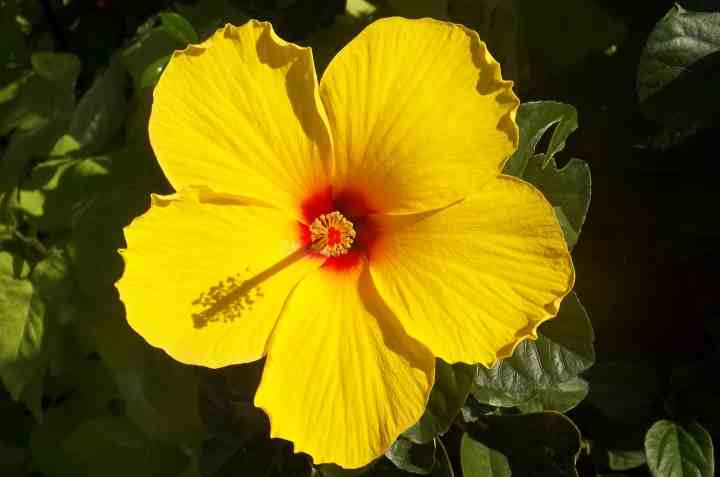
Ma’o Hau Hele (Hibiscus brackenridgei)
Hawaiian white hibiscus (Hibiscus arnottianus): A white-flowering shrub endemic to Hawaii. It’s identified by its white funnel flowers with a conspicuous red or pink protruding stamen. Apart from Hibiscus waimeae, it’s the only species of fragrant hibiscus flowers in the world.

Hawaiian white hibiscus (Hibiscus arnottianus)
Red Kauai rosemallow (Hibiscus clayi): Called Koki’o ‘ula’ula in Hawaii, this shrub has showy, bright, or dark red flowers with slender, spreading petals. Its appearance is like Hibiscus kokio, and it’s endemic to Kauai.
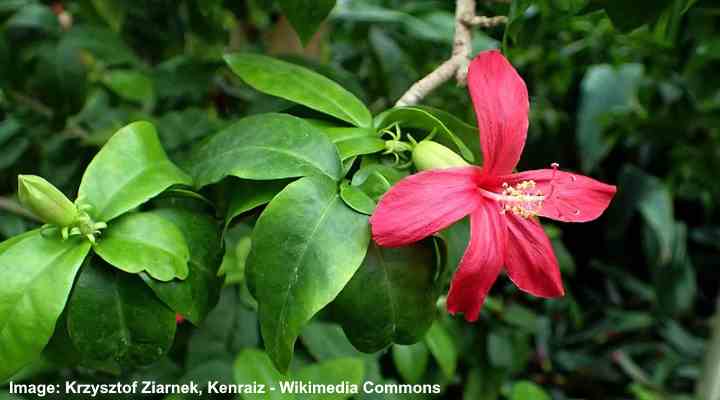
Red Kauai rosemallow (Hibiscus clayi)
Akiohala (Hibiscus furcellatus): Indigenous to Hawaii, this spreading shrub is known for its funnel-shaped pink or purple flowers growing on plants 6 to 8 ft. (1.8 – 2.4 m) tall.
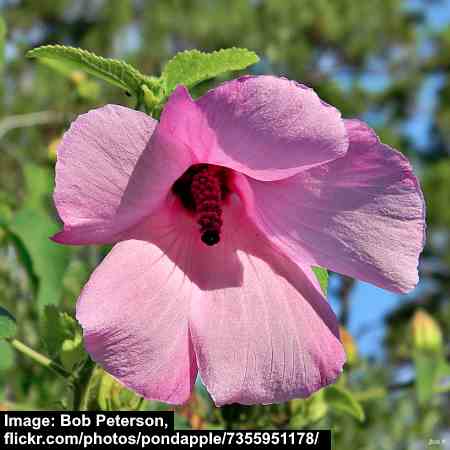
Akiohala (Hibiscus furcellatus)
Koki’o ke’oke’o (Hibiscus waimeae): The outstanding feature of this endemic Hawaiian plant is its brilliant white flowers that have a strong, sweet fragrance. Its native habitat is the Hawaiian island of Waimea.
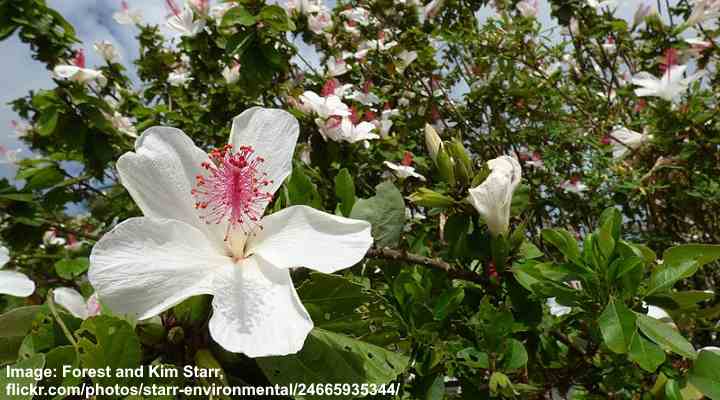
Koki’o ke’oke’o (Hibiscus waimeae)
Koki’o’ ula (Hibiscus kokio): This endemic species of hibiscus has beautiful orange flowers with narrow petals and a bright yellow and red stamen.

Hibiscus kokio subsp. saintjohnianus
Sea hibiscus (Hibiscus tiliaceus): Popular for growing in Hawaii’s coastal areas, this yellow-flowering hibiscus shrub has attractive yellow blossoms with dark red throats. Native to Hawaii, the flowering shrub is also popular in Florida.
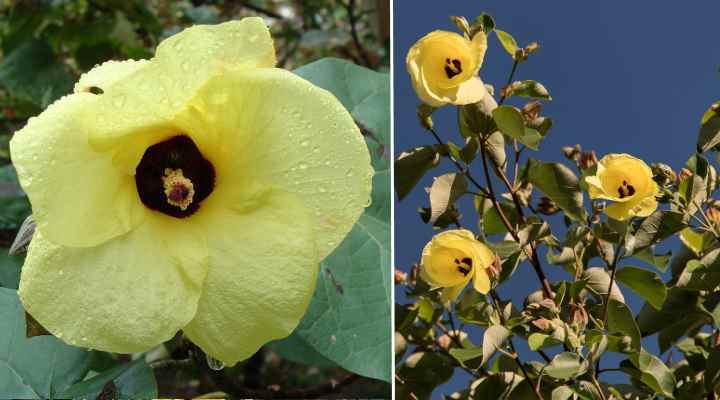
Sea hibiscus (Hibiscus tiliaceus)
Frangipani (Plumeria)
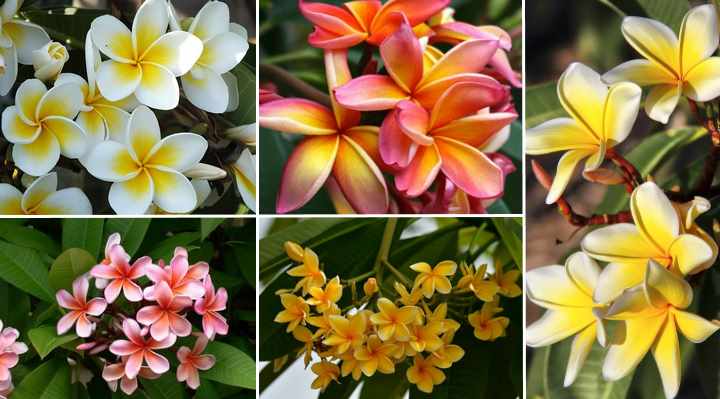
Plumeria flowers come in various colors
Frangipani, also known as Plumeria, is not native to Hawaii, although its colorful, exotic flowers have become a symbol of Hawaiian culture. This deciduous small tree is native to Central America, Mexico, and the Caribbean. Frangipani is a popular ornamental garden plant, celebrated for its fragrant flowers in shades of white, red, yellow, pink, and various pastels.
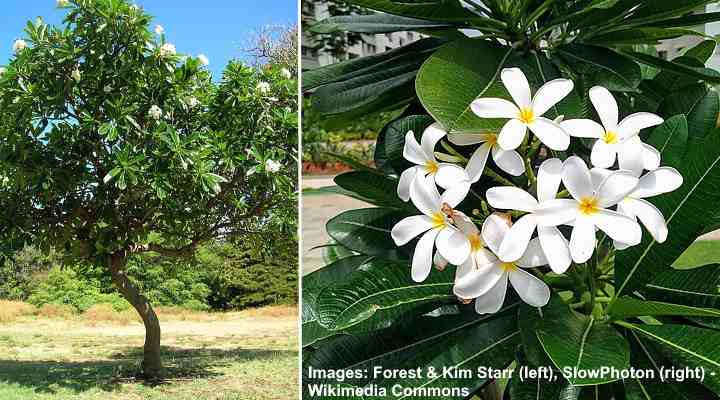
A white frangipani tree (Plumeria obtusa)
The tropical Frangipani tree has beautiful, fragrant, star-shaped flowers with a waxy texture. These flowers feature five symmetrically arranged petals that can have either rounded or pointed tips and vary in size, forming a perfect star shape.
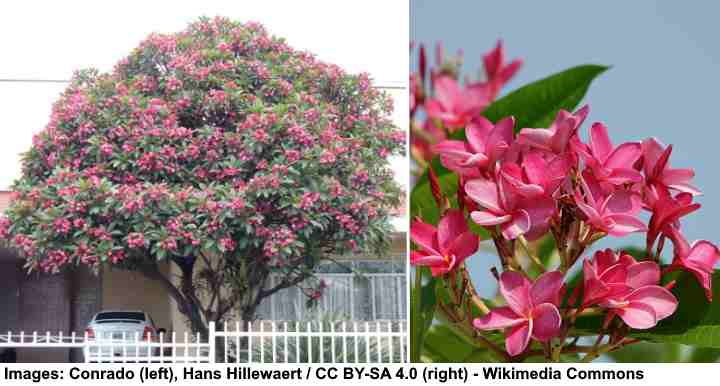
A red frangipani tree (Plumeria rubra)
The small tropical Frangipani can reach up to 20 ft. (6 m) in height but typically grows as a shrub, measuring 6 to 8 ft. (1.8 – 2.4 m) tall and wide.
Frangipani, also known as Plumeria, is one of the iconic flowers used in Hawaiian lei making. Lei making is the traditional Hawaiian craft of creating garlands from tropical flowers, shells, nuts, feathers, and leaves. The sweet fragrance and striking appearance of Plumeria blooms make them a preferred choice for lei. These garlands are worn during important life events and given as gifts of aloha to welcome visitors, commemorate milestones, and honor loved ones. Despite being a non-native Hawaiian plant, Plumeria has secured a solid place in local culture and traditions.
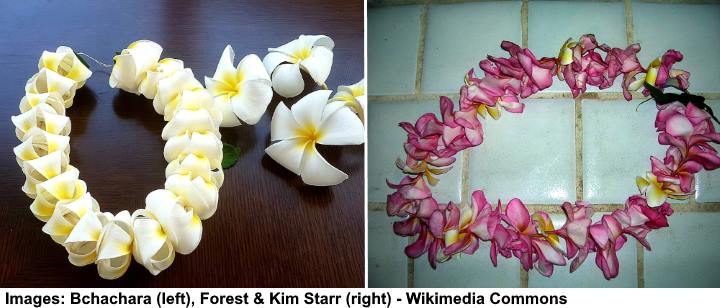
Frangipani leis
ʻŌhiʻa lehua (Metrosideros polymorpha)

The ‘Ōhiʻa Lehua, celebrated as Hawaii’s state tree and a sacred symbol within Hawaiian culture, is a native species that graces the six largest Hawaiian islands. Its distinctive red flowers, which form a pom-pom like cluster of stamens, are a vibrant contrast against the backdrop of its blue-green, leathery leaves, symbolizing the rich natural heritage of Hawaii.
In ideal conditions, ‘Ōhi’a lehua grows 66 to 82 ft. (20 – 25 m) tall. The endemic Hawaiian tree is also one of the most widespread trees on the islands. It grows in moist, dry, wet, and cloud forests and thrives in volcanic soils.
Depending on its growing conditions, the plant can grow as a prostrate shrub. In boggy areas of the islands, ‘Ohi’a lehua is one of the most common Hawaiian shrubs.
Beyond its ecological significance, the ‘Ōhiʻa Lehua is deeply embedded in Hawaiian culture as a sacred symbol. According to ancient Hawaiian legend, the ‘Ōhiʻa tree and Lehua flower represent two lovers, ‘Ōhiʻa and Lehua, tragically separated by the fire goddess Pele’s jealousy. Transforming ‘Ōhiʻa into a tree and Lehua into its flower, the legend says that picking a Lehua flower will bring rain, symbolizing the eternal tears of the separated lovers.
ʻIeʻie (Freycinetia arborea)
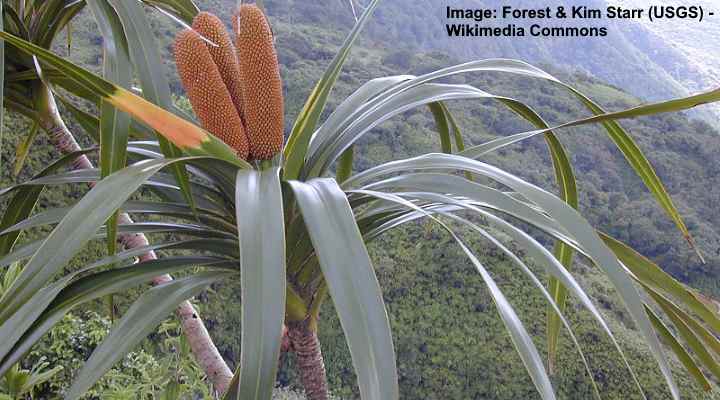
ʻIeʻie is a native Hawaiian climbing plant with slender, woody stems and distinctive aerial roots. The plant is characterized by salmon-orange pointed bracts creating spiked flowers. These are surrounded by shiny green, strap-like leaves. The indigenous plant is found in native forests, where it attaches itself to a host tree with its aerial roots.
‘Ie’ie is a vigorous, fast-growing climbing plant that can reach the forest canopy. Its woody stems can grow 60 ft. (18 m) long and root in the ground or climb tree trunks in moist forests. Its evergreen leaves measure 16” to 31” (40 – 80 cm) long and 1.18” (3 cm) wide.
Māmane (Sophora chrysophylla)
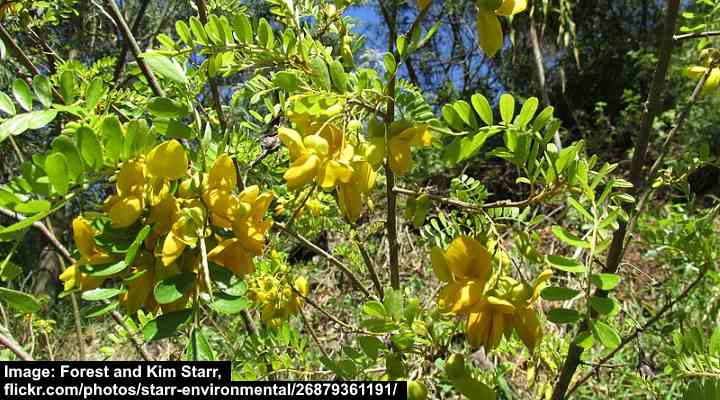
Māmane is an endemic plant species with dainty yellow flowers that bloom in winter and spring. Identifying features of the Hawaiian flower plant include clusters of yellow flowers, pinnately compound leaves with fuzzy yellow undersides, and twisted brownish-gray seed pods.
The Hawaiian shrub-like tree can grow up to 50 ft. (15 m) tall. However, it’s smaller when growing as a shrub. Its pinnate leaves have up to ten pairs of leaflets, each measuring 0.28” to 2” (0.7 – 5 cm) long.
Māmane is an endemic plant of Hawaii, found on six of the eight Hawaiian islands. It most commonly grows in dry forests at over 4,000 ft. (1,220 m). However, it also thrives in low shrublands and mixed mesic forests.
Hawaiian Cotton (Gossypium tomentosum)

Called ma’o or huluhulu in its native Hawaii, this yellow-flowering cotton plant grows in low shrublands. It’s endemic to the Hawaiian islands, where the shrub grows 5 to 10 ft. (1.5 – 3 m) tall. The shrub’s large, showy, yellow flowers bloom from late summer through winter.
This Hawaiian shrub has maple-like leaves measuring 5” (13 cm) in diameter with three to five lobes. Its bright yellow, hibiscus-like blooms contrast nicely with the silvery-green or gray-green foliage.
Hawaiian cotton is typically found in dry, rocky habitats and can tolerate drought conditions. The plant has long roots that reach deep into the soil, helping it to survive harsh environments. In Hawaiian landscapes, the low-growing shrub is used as a hedge or accent plant or trimmed to grow as ground cover.
Hawaiian Lobelioids
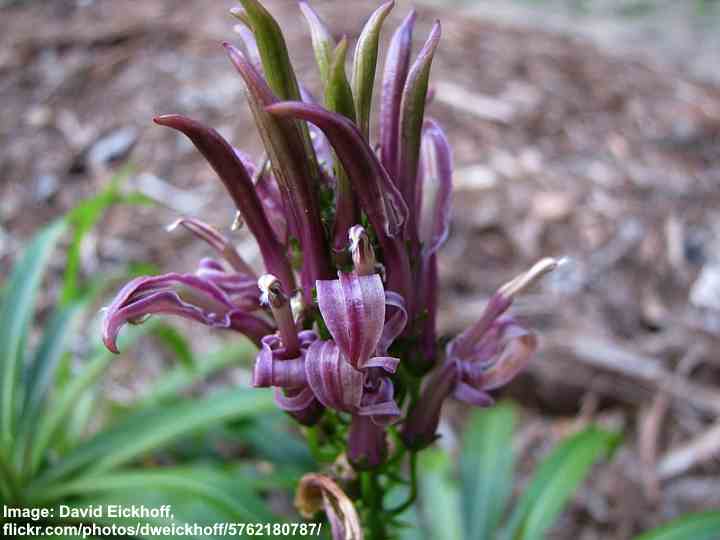
Niihau lobelia (Lobelia niihauensis)
Hawaiian lobelioids are a wide variety of flowering plants endemic to the Hawaiian islands. The native flowers are known for their unique, tubular-shaped, showy flowers. Flowers in the Lobelia genus bloom in blue, purple, pink, and red shades. Some of the most exotic flower types have clusters of curved petals forming horizontal or vertical spikes.

Large-spiked lobelia (Trematolobelia macrostachys)
Many Hawaiian Lobelioids are endangered or critically endangered due to habitat loss, invasive species, and other threats. Among the species, there is great variation in plant type. Some are vine-like climbers, whereas others grow as small tree-like shrubs with flowering spikes or loose clusters.
They are typically found in wet and montane forests, and their conservation is a priority for preserving Hawaii’s native flora.
Wai’anae Koko’olau (Bidens amplectens)

Wai’anae Koko’olau is a native flowering Hawaiian plant with eye-catching yellow ray flowers. The yellow oval petals surround a bronze-orange disc with seven to nine petals per flower. This herbaceous plant has slightly furry, pinnately compound leaves measuring 3.5” to 6” (9 – 15 cm) long.
The small perennial shrub grows 5 to 10 ft. (1.5 – 3 m) tall. The shrubby tropical bush grows in dry shrublands and coastal areas. Its attractive yellow flowers and deep green foliage add ornamental appeal to tropical garden landscapes.
Wai’anae Koko’olau is an endangered species endemic to the island of Oahu. Unfortunately, habitat loss and invasive plants threaten the shrub’s existence in the wild.
Cosmosflower Beggarticks (Bidens cosmoides)
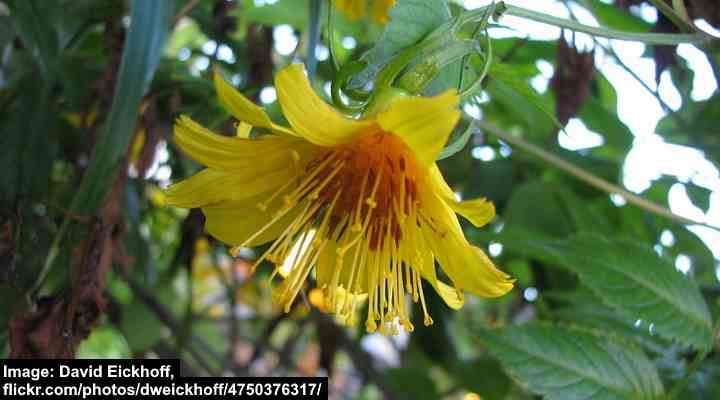
Cosmosflower beggarticks is a flowering climbing plant found on the Hawaii island of Kauai. The characteristics of the tropical plant are its showy yellow flowers and lanceolate green leaves. Its cup-shaped yellow flowers have daisy-like petals and showy stamens, measuring up to 3” (7.5 cm) in diameter.
The locals call the plant po’ola nui, a common Hawaiian plant for use in lei production. Apart from its spectacular yellow flowers, the plant has pinnate compound leaves 4” to 12” (10 – 30 cm) long, with up to nine pointed leaflets.
The sprawling stems of cosmosflower beggar ticks grow 3 to 8 ft. (0.9 – 2.4 m) long. Like many endemic plants on the Hawaiian islands, habitat loss and invasive weeds have put the yellow-flowering plant under threat.
Oahu Riverhemp (Sesbania tomentosa)

Also called ‘ōhai, oahu riverhemp blooms with eye-catching reddish-orange flowers. The red-flowering plant is endemic to the main Hawaiian islands. It grows as a small shrub or tree, reaching up to 15 ft. (4.5 m) tall. Its foliage consists of silvery-gray oval leaflets, and flowers are up to nine per cluster.
Growing in Hawaiian garden landscapes, oahu riverhemp has a spreading nature up to 10 ft. (3 m) in diameter. It also has distinctive, curved seed pods that measure 3” to 9” inches (7.5 – 22 cm) long. These seed pods contain small, rounded seeds that are dispersed by water.
When growing as a prostrate red-flowering shrub, oahu riverhemp is ideal as ground cover. However, in its shrub form, it acts as an accent plant, hedge, privacy screen, or tall tree.
Nanu / Forest Gardenia (Gardenia brighamii)

Nanu—or Na’u—is a small native Hawaiian tree with fragrant white flowers and dark green glossy leaves. The pure white tubular flowers have six or even lobes, a sweet scent, and measure 1” (2.5 cm) long. Additionally, the lush tropical plant glossy green, oval-shaped leaves up to 4” (10 cm) long.
Nanu is a slow-growing plant and grows up to 15 ft. (4.5 m) tall in its natural habitat of the major Hawaiian islands. In addition to the beautiful white flowers, the tropical beauty produces oval to round fruits containing several seeds.
‘Uki‘Uki (Dianella sandwicensis)

‘Uki‘uki is an indigenous native lily with small yellow and purple flower clusters. The characteristics of this Hawaiian clumping plant are its tufts of strap-like arching dark green leaves measuring 1.5 to 3 ft. (0.45 – 0.9 m) tall, small star-shaped flowers, and purple berries. The low-growing foliage plant thrives in full sun.
In its native habitat, ‘uki’uki thrives in dry shrublands, wet forests, and grassland on lava. In garden landscapes, the ornamental plant is ideal as ground cover in full sun or partial shade, border planting, or foundation planting. Although the purple berries are edible, they are not tasty.
Other uses in the landscape include container planting, understory planting, or accenting larger shrubs.
Beyond its aesthetic appeal, ‘uki’uki plays a significant role in Hawaiian culture. The durable fibers from its leaves are used in traditional lei making, providing material for intricate and meaningful garlands. Additionally, the purple berries serve as a source of natural dye, historically used in Hawaiian kapa (bark cloth) making. This cultural usage highlights the plant’s importance beyond its ornamental value, embedding it deeply in the heritage and practices of Hawaiian society.
Molokai Ohaha (Brighamia rockii)

Molokai Ohaha—or Pua ‘ala—is endemic to the Hawaii island of Moloka’i and blooms with white, trumpet-shaped flowers. The identifying features of this Hawaiian plant are its succulent tree-like trunk, white tubular flowers, and luscious, oval leaves measuring up to 9” (22 cm) in diameter. The leaves grow in a rosette pattern.
Molokai Ohaha grows 3 to 16 ft. (0.9 to 5 m) tall.
Molokai Ohaha has adapted to planting in residential landscapes. Its long, arching, branchless trunk-like stem with a rosette of leathery leaves and trumpet-shaped flowers give landscapes a distinctive appearance. The plant performs well in dry, windy, and exposed environments. It also thrives in containers with an airy soil mix.
Pua Kala / Hawaiian Poppy (Argemone glauca)
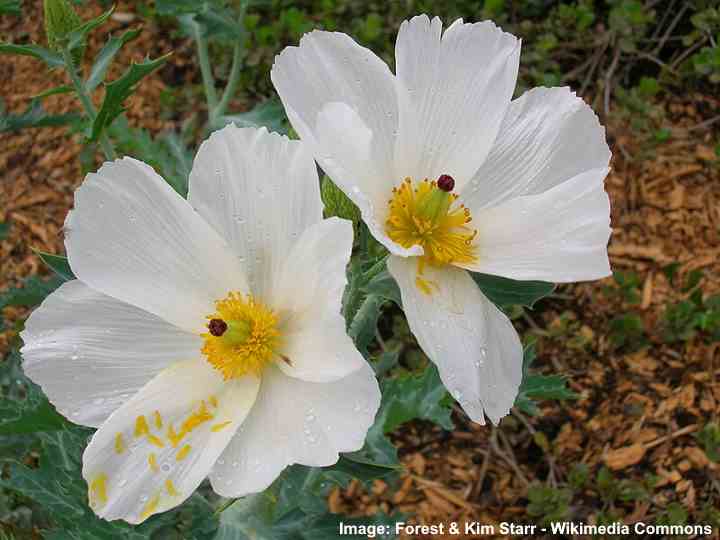
Pua Kala—or the Hawaiian poppy—is prized for its white flowers and upright stems covered in deeply cut foliage. Native to Hawaii, this plant has white, cup-shaped flowers with six white, papery petals surrounding a yellow center. The perennial herb has prickly stems with glaucous green leaves.
The Pua Kala plant grows as a clumping perennial, reaching 3 to 6 feet (0.9 – 1.8 m). It thrives in dry, rocky areas and is suitable for rock gardens and xeriscaping. It also tolerates poor soil conditions and performs well in sandy or volcanic soils.
Landscape uses for pua kala include a native border hedge, foundation planting, or specimen plant. Its thick, jaggy stems also help keep unwanted animals away from your garden. It’s also Hawaii’s only native poppy.
Naupaka (Scaevola taccada)
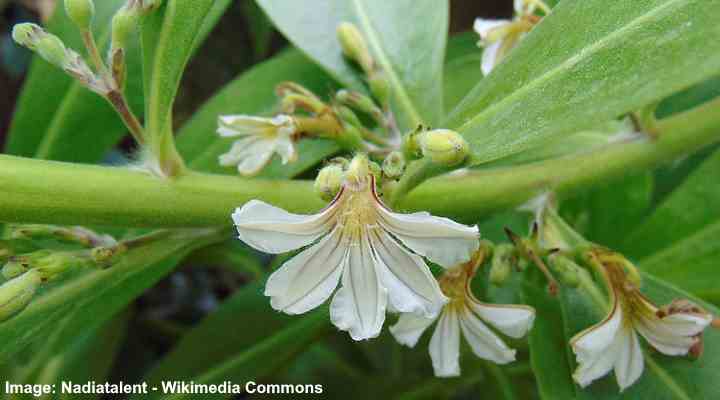
Naupaka is a bushy coastal plant blooming with unusually frilled white petals. This indigenous native Hawaiian flower has five petals in a half-ray or fan-like formation. It has succulent, heart-shaped, or oval leaves measuring 3.14” to 10” (8 – 25 cm) long. This Hawaiian shrub produces round, fleshy drupes.
Also called beach cabbage or sea lettuce, the tropical shrubs thrive in coastal landscapes on Pacific islands. It grows 3 to 12 ft. (0.9 – 3.6 m) tall and up to 15 ft. (4.5 m) across. Its dense, evergreen foliage makes the shrub ideal as a hedge, privacy screen, or evergreen ground cover.
Hāhā (Cyanea angustifolia)

Hāhā is a type of Hawaiian lobelioid with eye-catching clusters of purple and white tubular flowers. The flower clusters bloom under the tree’s canopy. The tree’s huge tropical leaves measure several feet long, forming a palm-like canopy on a branchless tree trunk. It grows up to 15 ft. (4.5 m) tall.
Aka ‘Aka ‘Aka (Hillebrandia sandwicensis)

Aka ‘aka ‘aka is a rare, endemic Hawaiian flower with beautiful cup-shaped white blooms and yellow stamens. This usual flowering plant has hairy, glossy green leaves with lobed margins. The white and pale pink flowers bloom from February through June, contrasting nicely with the green foliage. The flowering plant grows up to 4 ft. (1.2 m) tall.
Also called pu’a maka nui, the Hillebrandia sandwicensis is an unusual plant because it belongs to the begonia family Begoniaceae. However, it’s not in the genus Begonia. Its native habitats are the Hawaiian islands of Kauai, Maui, and Molokai.
Koki’o (Kokia cookei)
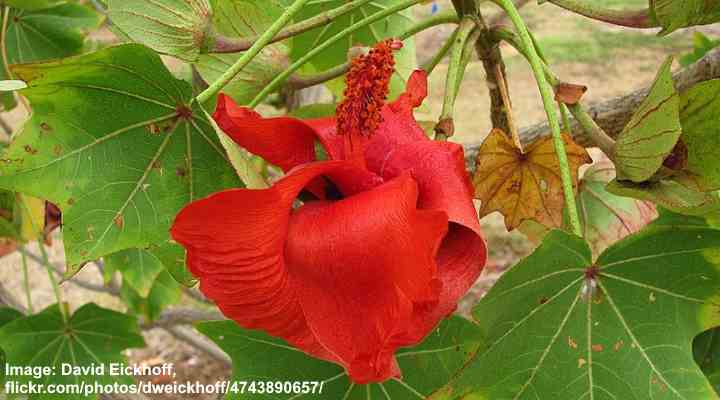
Koki’o is a red-flowering tropical plant endemic to the Hawaiian island Moloka’i. The Hawaiian tropical tree blooms with large red flowers consisting of twisted and recurved orangish-red petals. Its leaves measure 1” to 5” (2.5 – 13 cm) wide and have five to seven marginal lobes. Koki’o grows 10 ft. (3 m) tall.
Koki’o is a deciduous tree and one of the most endangered plants worldwide. Only a few grafted varieties remain in the wild.
Nehe (Melanthera integrifolia)

Nehe is a native Hawaiian coastal plant that is ideal for ground cover. The spreading Hawaiian shrub is characterized by its yellow daisy-like flowers measuring up to 0.66” (1.7 cm) in diameter. The yellow flowers appear above the foliage, which consists of elongated egg-shaped leaves. It spreads up to 7 ft. (2.1 m) wide.
Nehe’s natural habitat is along the sandy beaches and rocky shores of the Hawaiian islands. Therefore, it’s tolerant of sea spray, drought, poor soils, and full sun. The intertwining stems create dense foliage; however, it doesn’t become invasive in its natural habitat.
This coastal plant grows up to 3 ft. (0.9 m) tall and has a spreading habit. Its leathery leaves measure around 2” (5 cm) long. The flowers of Nehe are small and fragrant, and they bloom year-round, adding beauty to the Hawaiian coastline.
Hawaiian Iliau (Wilkesia gymnoxiphium)
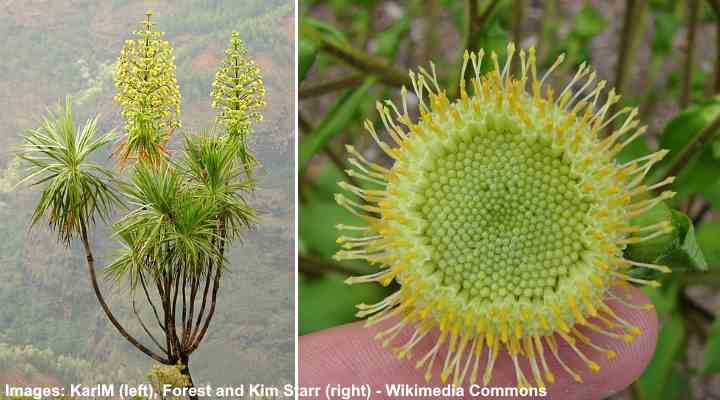
Hawaiian iliau is a flowering plant endemic to the Hawaiian island of Kauai. The unusual Hawaiian flower plant has woody stems up to 16 ft. (5 m) tall with a huge egg-shaped cluster of yellow daisy-like flowers blooming mid-summer. It has pointed, elongated leaves growing in whorls under the flower cluster.
Hawaiian Iliau is a shrub-like plant with an unbranched succulent stalk. Before flowering, the long, stiff leaves form a spiky crown. When flowering, the large flower cluster protrudes above the plant. Up to 350 small creamy-yellow flowers can bloom in a single cluster.
This Hawaiian flower plant thrives in dry soil and full sun in garden landscapes. It also grows in containers to add texture, greenery, and an exotic twist to garden landscapes.
Maiapilo / Hawaiian Caper (Capparis sandwichiana)

Maiapilo is a type of Hawaiian flower plant with stunning white flowers. The fragrant white blooms appear at night and have masses of long, showy stamens. These white blossoms contrast with the oval leaves that are thick, dark green, and leathery. It blooms throughout the year.
The small sprawling plant grows up to 5 ft. (1.5 m) tall and 15 ft. (4.5 m) wide. The beautiful flowering plant performs well in dry, shallow, rocky soil, tolerating full sun and drought. You can plant it in a coastal garden as a small hedge, ground cover, or spreading plant for lava rock gardens.
Hawaiian Red Cranesbill (Geranium arboreum)
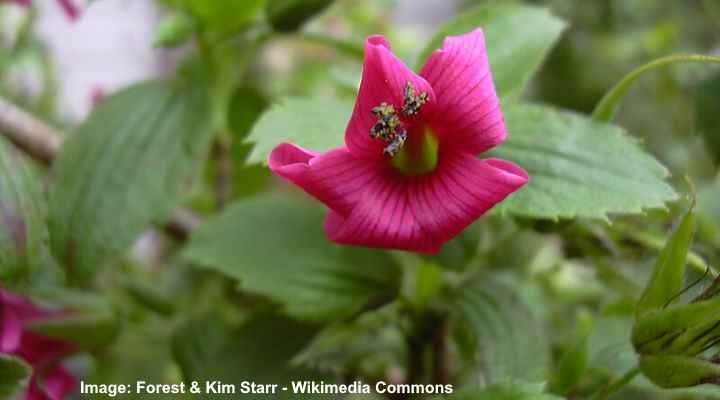
The Hawaiian red cranesbill is a flowering species native to the Hawaiian island of Maui. The native flowers are known for their vibrant red or magenta colors and recurved petals. This perennial Hawaiian shrub has lanceolate leaves with toothed edges and measures 1.6” (4 cm) long. The shrubby plants grow up to 13 ft. (4 m) tall.
Also called nohoanu, the red-flowering geranium is unique among the genus. It’s the only one in the genus that birds pollinate, and it’s only found on Maui.
The plant grows 6.6 – 13 ft. (2 – 4 m) tall and has green-lobed leaves on top and reddish-purple on the undersides. The red flowers form clusters at the end of the branches and have five petals.
Hawaiian red cranesbill is a popular choice for landscaping due to its striking red flowers and ability to withstand drought conditions. It is also an important plant for native Hawaiian birds and insects, providing them with a rich nectar source and habitat.
Silver Geranium (Geranium cuneatum)
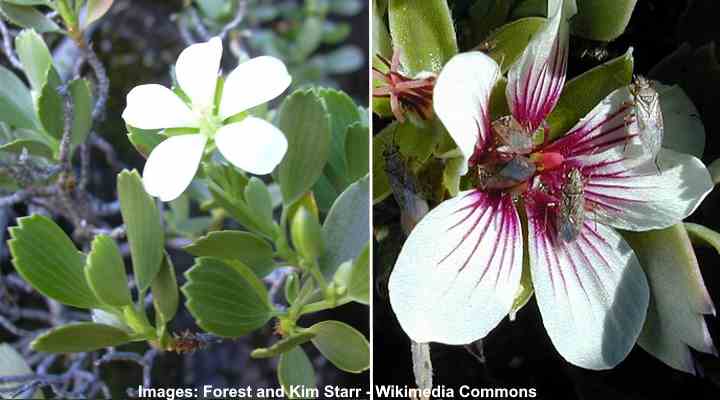
Geranium cuneatum subsp. cuneatum (left) and geranium cuneatum subsp. tridens (right)
Silver Geranium—locally known as hinahina—is a white-flowering native to Hawaiʻi Island and Maui. The small, bushy Hawaiian flower plant has silvery-gray foliage covered in tiny hairs. The shrub blooms with five-petalled white flowers, sometimes featuring purple veins. The native shrub thrives in coastal areas, growing on rocky or sandy soil.
Silver geranium shrubs grow 1 to 3 ft. (0.3 – 0.9 m) tall and wide. The small alpine bushy plants are ideal as ornamental shrubs, white-flowering ground cover, or foundation planting.
Its leaves are covered in fine hairs that help protect the plant from high winds and salt spray. The plant produces small white flowers in clusters, adding a delicate touch to its silver foliage. The shrubby plant grows in open, drier areas and higher elevations in its natural habitat.
Lilikoʻi / Passion Fruit (Passiflora edulis)

Lilikoʻi—commonly known as passion fruit—is a non-native vining plant that grows well in Hawaii. The outstanding feature of the perennial fruit-bearing vine is its showy purple and white flowers. The large flowers measure up to 3” (7.5 cm) wide with white petals that form a fringe.
The passion fruit vine was introduced to Hawaii and quickly became naturalized in the islands. Its purple fruit is highly valued for its sweet, tart flavor and fleshy, gelatinous pulp.
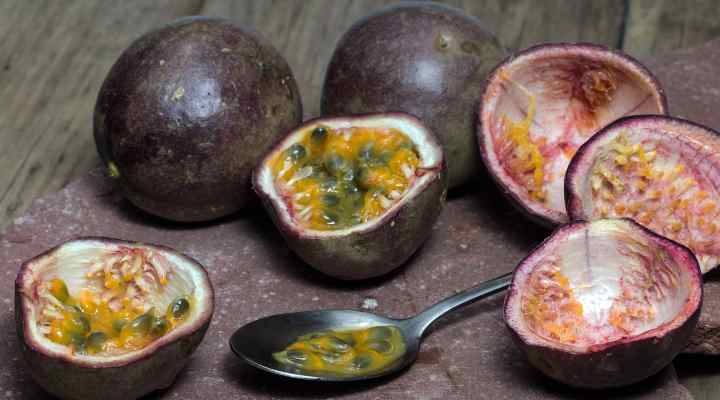
Passion fruit
In Hawaii, passion fruit vines are ideal landscaping solutions for decorating arbors, pergolas, and trellises. Its edible fruits are used to make desserts, jams, or marinades for meat. Also, a local delicacy—lilikoi butter—is a tasty fruit curd.
Dragon Fruit (Pitaya)

Dragon fruit, also known as pitaya, is a tropical fruit that has become popular in Hawaii. This unique cactus plant features flat, triangular arching stems. The plant blooms at night with showy cup-shaped white flowers with yellow centers several times a year. The unmistakable cactus fruit has vibrant pink, scaly skin surrounding crunchy, sweet, white flesh.
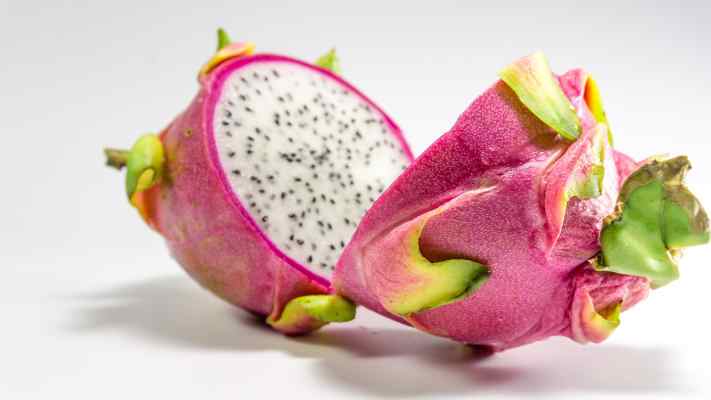
Dragon fruit (pitaya)
Dragon fruit stems have a sprawling, creeping, or climbing habit. Its white flowers are 12” (30 cm) long, and the egg-shaped, pink-skinned fruits are 5” (13 cm) long. The sprawling vines are common in tropical landscapes.
Red Ginger (Alpinia purpurata)

Red ginger is a tropical plant with brightly colored red flower-like bracts. Native to Malaysia, the striking red tropical flowers make it a popular ornamental plant in Hawaii, especially on Hawaii’s Big Island. The red blooms are clusters of bright red, cone-shaped flowers that resemble torches or an ostrich’s plume.
Red ginger has leafy cane-like stems that grow 3 to 15 ft. (0.9 – 4.5 m) tall and 4 ft. (1.2 m) wide. Its striking red flowering spikes can grow 12” (30 cm) tall, created by funnel-shaped bracts. The plant’s oblong leaves grow up to 32” (81 cm) long and 9” (23 cm) wide.
The striking red or pink cone-shaped flower heads add tropical flair to Hawaiian gardens and are popular in floral arrangements. You can also plant red ginger as a border plant or focal point, enhancing the aesthetics of tropical and subtropical landscapes.
Kanawao (Broussaisia arguta)

Kanawao is a Hawaiian flowering plant native to all the main islands. This flowering type of Hawaiian hydrangea features star-shaped purple flowers with showy stamens. The beautiful flowers form rounded or flattened clusters 2” to 4.5” (5 – 11 cm) in diameter. The large tropical leaves are 10” (25 cm) long and pointed at both ends.
The natural habitat of Kanawao on Hawaii’s islands is mesic or wet forests and moist valleys at higher elevations. The tropical hydrangea shrub grows 5 to 10 ft. (1.5 – 3 m) tall and has a spreading growth habit.
Tropical Bird-of-Paradise (Strelitzia)

The bird-of-paradise is a stunning tropical plant with distinctive flowers resembling a crane’s head. Although Strelitzia isn’t native to Hawaii, it’s popular in Hawaiian gardens. Its flowers have bright orange or yellow petals and a blue tongue-like structure emerging from the center. Its leaves are grayish-green and grow in clumps.
Bird-of-paradise flowers bloom on upright, sturdy stems 4 to 5 ft. (1.2 – 1.5 m) tall. These spectacular flowers rise above the plant’s dark green, banana-like leaves measuring up to 2 ft. (0.6 m) long.
The tropical bird of paradise adds a touch of exotic beauty to Hawaiian gardens. The plant isn’t invasive or negatively impacts local ecosystems despite being introduced to the islands.
‘Akoko (Euphorbia celastroides)

‘Akoko is a Hawaiian shrubby plant native to Hawaii, especially the islands of Maui and Kauai. The low-growing, upright shrub has blue-green, narrowly obovate leaves, clusters of small whitish-yellow flowers, and reddish fruits. The attractive shrub grows up to 5 ft. (1.5 m) tall.
‘Akoko is typically found in dry, coastal areas and thrives growing on rocky slopes and cliffs. It can withstand intense winds, drought, and salt spray. The plant is an important part of the Hawaiian ecosystem, providing food and habitat for native birds and insects.
‘Akoko shrubs perform well as small hedges, ornamental specimen plants, and foundation planting.
Ko’oloa’ula (Abutilon menziesii)

Ko’oloa’ula is a small hibiscus-type Hawaiian shrub with showy red flowers 1” (2.5 cm) in diameter. The pink, salmon-pink, pale red, maroon, or red showy flowers have five papery petals and a yellow center, creating a striking contrast. The heart-shaped leaves of the woody shrub have toothed margins and measure up to 3.1” (8 cm) across.
A member of the mallow family (Malvaceae), Ko’oloa’ula is endemic to Hawaii. Ko’oloa’ula shrubs grow 6 to 10 ft. (1.8 – 3 m) tall. Landscaping uses for the drought-tolerant tropical shrub include accent plants in xeric landscaping, privacy screens, and evergreen flowering hedges.
Pikake (Jasminum sambac)
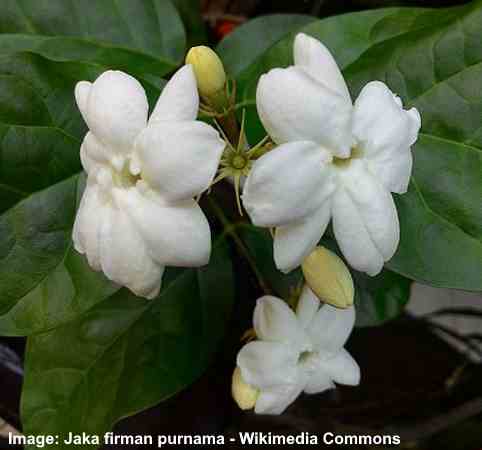
Pikake is a beautiful white, fragrant flower often used in Hawaiian lei garlands. Native to Southeast Asia, it has become a beloved shrubby vine thanks to its stunning star-shaped flowers, lush foliage of pointed leaves, and long blooming period. The white flowers open at night and emit strong scents.
Despite being introduced to the Hawaiian islands, the flowers have a place in local culture and traditions. In the main Hawaii islands, the shrubs are grown in residential landscapes for their ornamental value or commercially for producing lei flowers.
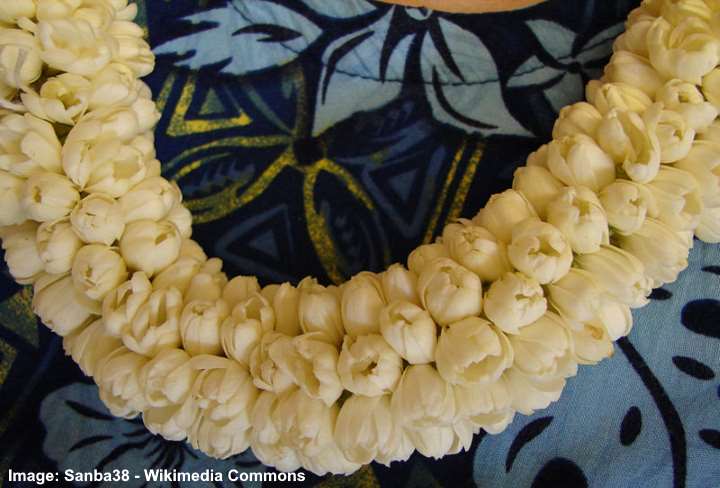
Pikake lei
The small white-flowering shrubs or vines grow 1.6 to 10 ft. (0.5 – 3 m). The strongly scented white flowers measure 1.18” (3 cm) in diameter, and the leaves are 5” (13 cm) long.
Kou / Beach Cordia (Cordia subcordata)

Kou is a common orange-flowering tree found in Hawaii. The ornamental features of this tropical tree are tube-shaped orange flowers with a ruffled appearance, large ovate leaves 8” (20 cm) long, and spherical brown seeds 1.18” (3 cm) in diameter. Kou trees grow 23 to 33 ft. (7 – 10 m) and bloom throughout the year.
Also known as beach cordia, kou trees have a long history in Hawaiian traditions as lei flowers and timber to make food utensils.
It’s thought that kou trees arrived in Hawaii as Pacific Ocean currents brought the seeds from Asia and Polynesian islands.
FAQs About Hawaiian Tropical Flowers
What are some examples of beautiful Hawaiian tropical flowers?
Hawaiian hibiscus species produce some of the most attractive native flowers on the islands. These funnel-shaped tropical flowers bloom in red, orange, pink, white, and yellow shades. Other beautiful flowers from Hawaii include plumeria, orchids, and the exotic bird-of-paradise. The striking colors of the blooms showcase Hawaiian culture and traditions.
Can I grow these Hawaiian tropical flowers in my garden?
Growing Hawaiian tropical flowers in your garden may be challenging. Many native plants require specific climate conditions to thrive. Hawaii’s USDA hardiness zones range from 9 to 13. However, some varieties, like plumeria and hibiscus, can thrive in warm climates with well-drained soil. Consult local nurseries for suitable options and care advice.
Where can I see these beautiful Hawaiian tropical flowers?
To see beautiful Hawaiian tropical flowers, visit botanical gardens like the Foster Botanical Garden in Honolulu or Maui’s Kula Botanical Garden. Additionally, explore natural settings, such as Haleakalā National Park, where native flora, including unique flowers, flourish.
However, you may not have to visit Hawaii to see native flowering plants. Many botanical gardens worldwide have tropical gardens and greenhouses showcasing Hawaiian flower plants.
Are there any special meanings or symbolism associated with these Hawaiian tropical flowers?
Many native Hawaiian flowers have special symbolism and are used in leis. For example, the Hawaiian hibiscus represents joy and happiness, whereas the plumeria flower represents new beginnings. In contrast, the red ginger flower represents wealth, passion, and diversity.
In Hawaiian culture, the plumeria flower is often used to symbolize a woman’s romantic status. If the flower is worn behind her right ear, it signifies that she is open and willing to meet a romantic partner. However, behind her left ear, she is already in a romantic relationship.
What is the sacred flower of Hawaii?
‘Ōhi‘a lehua is considered the most sacred flower of Hawaii. It’s the first tree to spring up after a lava flow. Therefore, it represents strength, skill, and love. Native Hawaiian traditions refer to ohia lehua as sacred to the goddess of the volcano, Pele, and goddess of hula, Laka.
Related articles:
